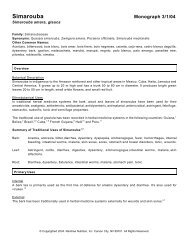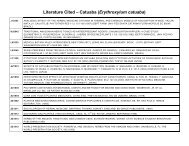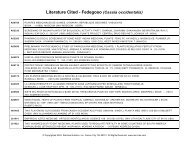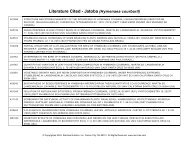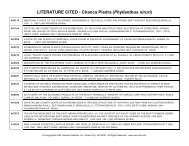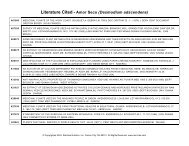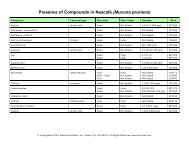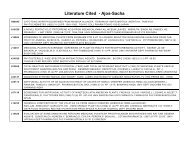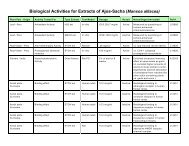Organ Specific Guide - Raintree Nutrition, Inc
Organ Specific Guide - Raintree Nutrition, Inc
Organ Specific Guide - Raintree Nutrition, Inc
Create successful ePaper yourself
Turn your PDF publications into a flip-book with our unique Google optimized e-Paper software.
CHUCHUHUASI EXTRACT<br />
Description: Indigenous people of the Amazon rainforest have been using the bark of chuchuhuasi<br />
medicinally for centuries; it's name means "trembling back" which describes its long history of use for back<br />
pain. <strong>Raintree</strong> <strong>Nutrition</strong>'s chuchuhuasi concentrated extract uses new and proprietary extraction methods<br />
to concentrate and preserve the active ingredients found in this amazing rainforest plant. It is rich in active<br />
and beneficial phytochemicals which occur naturally in this plant. The extraction methods used provides the<br />
equivalent of approximately 500 mg of chuchuhuasi bark per milliliter of extract—resulting in a highly potent<br />
concentrated extract.<br />
Traditional uses by organ or system: Adrenal: To cool, balance and support adrenal function.<br />
Musculoskeletal: As an analgesic, a muscle relaxant, and an anti-inflammatory for arthritis, rheumatism,<br />
and back pain.<br />
Ingredients: 100% pure chuchuhuasi bark (Maytenus krukovii) extracted in distilled water and 40% ethanol.<br />
Suggested Use: Take 60 drops (2 ml) 2-3 times daily or as needed.<br />
Contraindications: Not to be used during pregnancy or while breast-feeding.<br />
Drug Interactions: None reported.<br />
Other Practitioner Observations and Possible Precautions: None reported.<br />
Synopsis of research: (Please the online Tropical Plant Database for Chuchuhuasi for all cited<br />
research.)<br />
In the Peruvian Amazon, chuchuhuasi is traditionally used as a muscle relaxant, aphrodisiac, and<br />
analgesic, for adrenal support, as an immune stimulant, and for menstrual balance and regulation. In<br />
Peruvian herbal medicine systems, chuchuhuasi alcohol extracts are used to treat osteoarthritis, rheumatoid<br />
arthritis, bronchitis, diarrhea, hemorrhoids, adrenal disorders and menstrual irregularities and pain.<br />
Chuchuhuasi's long history of use has fueled much clinical interest in the research community. In the<br />
1960s, an American pharmaceutical company discovered potent immune-stimulating properties of a leaf<br />
extract and a bark extract, documenting that it increased phagocytosis in mice. Researchers reported that<br />
alcohol extracts of the bark evidenced anti-inflammatory and analgesic activities in various studies with<br />
mice, which validated chuchuhuasi's traditional uses for arthritic pain. Its anti-inflammatory action again was<br />
reported in the 1980s by an Italian research group. They reported that this activity (in addition to radiation<br />
protectant and antitumor properties) were at least partially linked to triterpenes and antioxidant chemicals<br />
isolated in the trunk bark. Research published in 2006 reportes that crude chuchuhuasi extracts evidenced<br />
potent antioxidant and antimutagenic actions.<br />
In 1993, a Japanese research group isolated another group of novel alkaloids in chuchuhuasi that may<br />
be responsible for its effectiveness in treating arthritis and rheumatism. In the United States, a pharmaceutical<br />
company studying chuchuhuasi's anti-inflammatory and anti-arthritic properties determined that<br />
these alkaloids can effectively inhibit enzyme production of protein kinase C (PKC). PKC-inhibitors have<br />
attracted much interest worldwide, as there is evidence that too much PKC enzyme is involved in a wide<br />
variety of disease processes (including arthritis, asthma, brain tumors, cancer, and cardiovascular disease).<br />
A Spanish research team found more new phytochemicals in 1998, one of which was cited as having<br />
activity against aldose reductase. (This enzyme is implicated in nerve damage in diabetic patients.)



